Context: The Dutch Domestic Interior
Following its invention in early quattrocento Italy, linear perspective, which allows the artist to establish a measurable relationship between object, pictorial plane and observer, became an indispensable skill for any artist who wished to compete on an international scale. European painters overwhelmingly employed one-point, or central, perspective, in which foreshortened objects are aligned perpendicularly with respect to the observer (fig. 1).
Italian, German and French painters occasionally experimented with two-point perspective to represent isolated objects set obliquely to the viewer's line of sight, but two-point perspective began to be pointedly exploited in the 1650s and 1660s by church painters working in Delft, including Gerard Houckgeest (1600–1661) and Emmanuel de Witte. The first illustrations of two-point perspective (fig. 2) can be found in Jean Pélérin's De Artificiali perspectiva published in 1505.
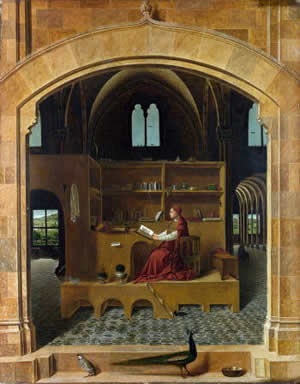
Antonello da Messina
c. 1474–1475
Olio on panel, 45.7 x 36. cm.
National Gallery, London
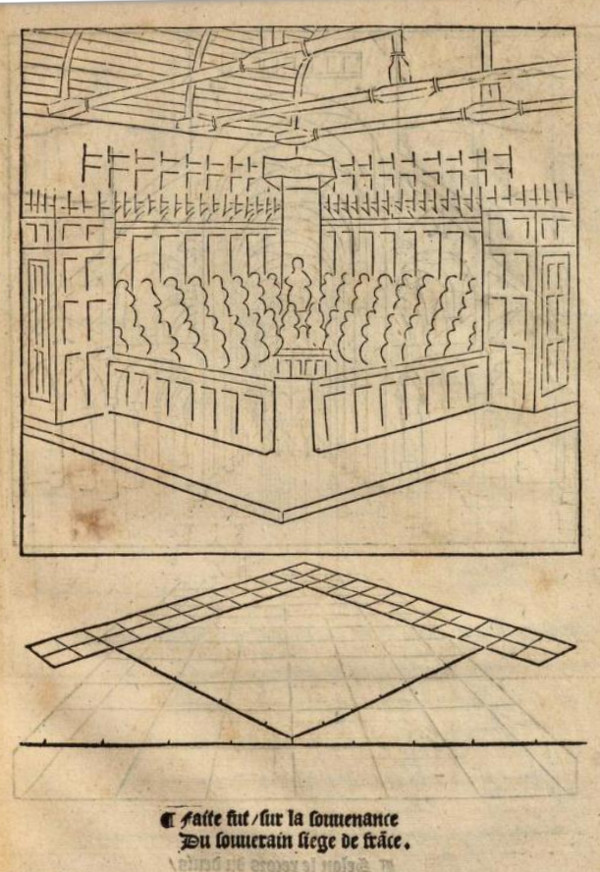
Jean Pélérin
1505
printed by Toul, P. Jacques, Paris
On the other hand, Dutch domestic interior painters continued to adhere strictly to the planar convention most likely because the oblique view creates a destabilizing effect which is at odds with the atmosphere of domestic tranquility, the raison d'être of this popular category of painting. Cornelis de Man's The Goldweigher (fig. 3), which had no influence on contemporary painters despite its compositional innovation, illustrates both points.
Excluding the earlier Dutch architectural painters, whose cavernous Renaissance fantasy interiors (fig. 4 & 5) are scarcely related to actual domestic environments, painters working in this category employed the most basic construction methods. The majority of Dutch artists seem to have created spatial illusion using the simplest of methods, such as a chalked string attached to a pin placed in the central vanishing point.
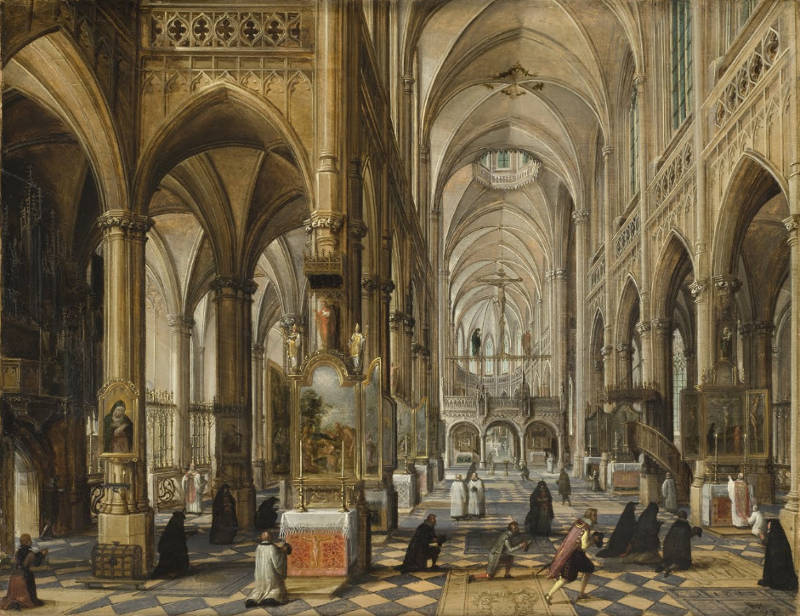
Paul Vredeman de Vries
1612
Oil on wood, 61.59 x 79.37 cm.
Los Angeles County Museum of Art, Los Angeles
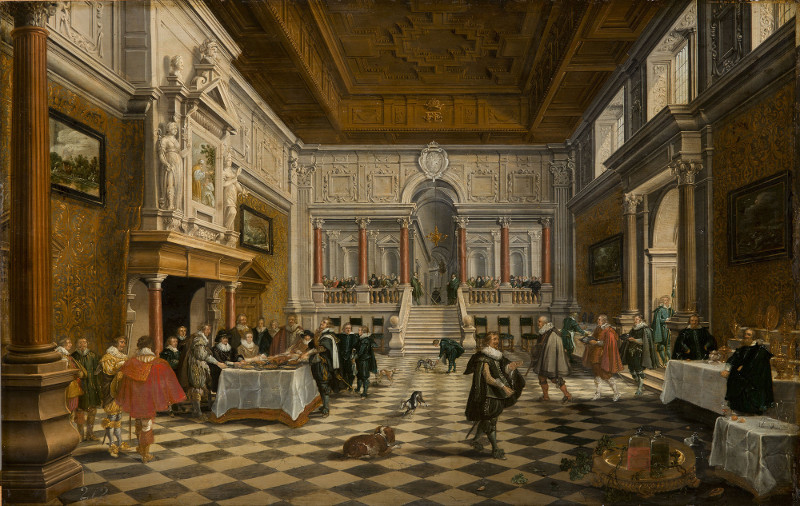
Bartholomeus van Bassen
Oil on panel, 57.5 x 87 cm.
North Carolina Museum of Art, Raleigh, N.C.
Setting aside a few isolated exceptions (see Jan Steen's The Sick Girl 1660 and Cornelis de Man's The Goldweigher c. 1670), the overwhelming number of Dutch domestic interior scenes follow a standardized layout. The far wall, without windows, is viewed frontally. Sometimes a wall is seen to the left, with one or two windows visible. Even when the windows are not pictured, light always comes from this direction. Some interiors featured showy tiled floors, set perpendicularly to the background wall, but simple wooden planks, which offer fewer challenges in perspective than tiled floors, were generally the rule. The right-hand wall is rarely visible. An early model of the domestic interior was Isaack Koedijck's A Man in an Interior Holding a Glass, Two Servants Kissing in a Doorway (fig. 6), of 1648. This complex interior space incorporates a room glimpsed through a narrow hallway, rafters, a carpet-covered table and partially open windows, all governed with one-point perspective. Curiously, the vanishing point falls exactly on a deer's foot which hangs suspended on a string from the ceiling.
Isaack Koedijck
1648
Oil on panel, 66 x 55 cm.
Private collection (?)
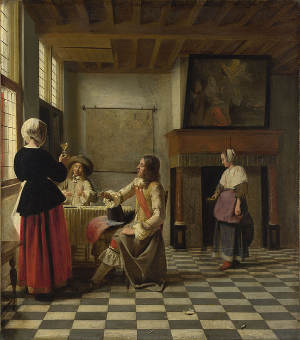
Pieter de Hooch
C. 1658
Oil on canvas, 73.7 x 64.6 cm.
National Gallery, London
In general, the application of linear perspective to the domestic setting was less than rigorous. Some of Jan Steen's interiors are precisely devised while others indicate little concern with accuracy. Distance points were routinely placed too close to the vanishing point creating an unnatural funnel-like perspective. On the other hand, Pieter de Hooch (1629–1684) and Vermeer, who worked closely together in Delft for a brief period, strove for a higher and more consistent level of perspectival precision (fig. 7). The London architect Philip Steadman calculated that the accuracy of Vermeer's perspectives is such that the distances points created by the floor tiles,Philip Steadman, Vermeer's Camera: Uncovering the Truth behind the Masterpieces (Oxford: Oxford University Press, 2001). which should in theory be exactly the same distance from the central vanishing point, never differ by more than a few per cent.
Despite the fact that Vermeer's perspectives are indeed more carefully contrived than those of his close colleagues, the problems presented in his relatively simple settings should not be exaggerated. They present no unusual technical difficulty that the architectural painters of The Hague and Delft had not already addressed. It is only the degree of geometric and dimensional accuracy that was pursued by the artist that makes them different.
Vermeer employed one-point perspective to render the perpendicularly aligned architectural elements and movable objects, and two-point perspective to define the floor tiles, chairs, stools window frames that are pictured obliquely. There is no evidence that he constructed anything like a full perspectival projection like those discovered beneath the uppermost paint layers of the architectural works of Bartholomeus van Bassen.
The Evolution of Vermeer's Perspectives
Please note that the links to Vermeer's paintings below lead to the interactive catalogue entries. Perspective diagram of each work can be accessed by clicking here.
Being free of geometrical objects, Vermeer's early Diana and her Companions shows no evidence of linear perspective, although the strong tilt of the brass basin located near the lower left-hand edge of the composition suggests the painter's eyepoint was relatively near the scene. In the next painting, Christ in the House of Martha and Mary, a series of tentatively defined architectural features on the left-hand side of the composition produce a few projective lines which, however, fail to lead to a single vanishing point. This suggests that the perspective was, in painter's jargon, eye-balled.
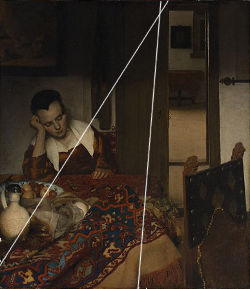
Johannes Vermeer
c. 1656–1657
Oil on canvas, 87.6 x 76.5 cm.
Metropolitan Museum of Art, New York
The Procuress shows no sign of progress. It seems to present two incompatible viewpoints, one looking up to the figures, the other looking down on the table.Philip Steadman, Vermeer's Camera: Uncovering the Truth behind the Masterpieces (Oxford: Oxford University Press, 2001). This creates the impression that the Westerwald wine jug set on the right-hand corner of the table is about to topple to the ground, even though the object itself is rendered with exceptional verisimilitude.
In A Maid Asleep (fig. 8) the uncertain orthogonals produced by parallel strips of the carpet's design—the part which lies flat on the tabletop—would appear to converge, oddly, somewhere near the top of the picture. This tells us that the artist stood while working and that he had stationed his easel very close to the table, looking down at almost everything represented in the picture. The perspective lines of the foreground chair come relatively close to intersecting at a point near the horizon line established by the carpet's orthogonals, although there is no way to determine if this is a coincidence or a purposeful but not particularly careful application of linear perspective.
The artist's apparent lack of familiarity with the expressive potential and the basic rules of linear perspective in these early works suggests he had not appropriated this skill during his apprenticeship, as would have been expected of a painter trained in history painting. Such a lacuna seems all the more noteworthy in the light of the fact that a group of architectural painters working in Delft and nearby The Hague had mastered the use of linear perspective as applied to exterior and interior settings decades previous to Vermeer's foray into painting.
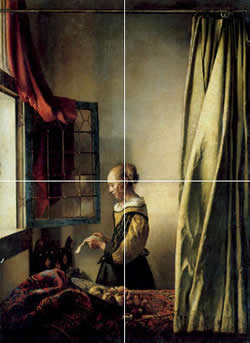
Johannes Vermeer
c. 1657–1659
Oil on canvas, 83 x 64.5 cm.
Gemäldegalerie Alte Meister, Dresden
Notwithstanding the faltering first steps, the young Vermeer made progress rapidly. In Girl Reading a Letter by an Open Window the orthogonals of the massive timber window frame converge correctly at a single point to the right of the figure, a bit behind the curtain. The perspective lines of the window casement—the hinged part that holds the glass panes—are somewhat less coherently designated, but nonetheless indicate that the painter was aware that obliquely viewed objects necessitate their own set of vanishing points. This notion alone betrays a relatively sophisticated use of linear perspective which would have likely been beyond reach, or interest, of the average Dutch painter.
Daniel Lordick's technical studyDaniel Lordick, "Parametric Reconstruction of the Space in Vermeer's Painting 'Girl Reading a Letter at an Open Window,'" Journal for Geometry and Graphics, vol. 16 (2012), no. 1, 69–79. of the painting reveals that the horizon line divides the canvas almost exactly into two halves (fig. 9). The vertical line which passes through the girl's center of gravity (the perpendicular line through her ear) divides the canvas into two halves as well, proving, Lordick believes, that the young painter had begun to employ geometry as an organizing principle for composition. Since the horizon line passes through figure's forehead, the painter worked while standing and, perhaps, he was only slightly taller than she (about 55 cm.). The fact that the first secure signs of linear perspective suddenly appear in Girl Reading a Letter at an Open Window together with what many art specialists consider to be the single most characteristic visual evidence of camera obscura vision (e. i., pointillés) may suggest that Vermeer had begun to use the camera obscura as an aid to painting.However, linear perspective is a natural ally of the interior setting, which could have been theoretically produced by geometric construction or the drawing frame as well.
In Officer and Laughing Girl Vermeer lowered the horizontal line for the first time. The fact that it passes directly through the eye level of the young girl indicates that the artist most likely worked while seated. The painting is also the first canvas which presents a pin prick at the vanishing point, revealing the artist's desire to create increasingly controlled perspective. Critics have frequently commented on the extreme difference in size between the two figures in terms of Vermeer's having used a camera obscura. However, with the laws of linear perspective and mathematics in hand Thomas O. Halloran has calculated that the officer is apparently much larger simply because he is sitting at quite a distance forward from the table, very near the position of the painter's eye. Thus, the camera itself is not responsible for the jarring effect of foreshortening, but rather, the fact that the viewpoint is so close to the scene, whether that be the position of the camera's lens or the painter's eye. Halloran calculated that the center of the seat of the officer was 90 cm. closer to the viewpoint than the near edge of the table. Since the woman is about 1.7 times farther from the viewer than the officer, he ought to have almost twice her dimensions on the picture plane, as he does. Halloran also maintains that, allowing for likely differences in clothing thickness and the fact that the young girl is leaning forward, the otherwise imposing officer does not seem to have been especially tall; his erect sitting height is only 2 or 3 cm. greater than hers. According to Halloran, the only anomaly in perspective is that the open casement is foreshortened more than it should be and that it looks as if it were more widely open, although he argues that Vermeer may have done it for that purpose.Thomas O. Halloran, "Reconstructing the Space in Vermeer's 'Officer and Laughing Girl.'" Anistoriton, vol. 8, September 2004, Section P043. http://www.anistor.gr/english/enback/p043.htm
However, the relative randomness of the vanishing lines produced by the braces and the tips of the lions-head finials of foreground chair suggest either that they had not been carefully considered, or, that the original perspective lines became corrupted during the painting process, which leads to an inevitable uncertainty when we attempt to interpret their angles. Instead, the perspective lines of the back of the girl's chair converge nicely upon the horizon line.
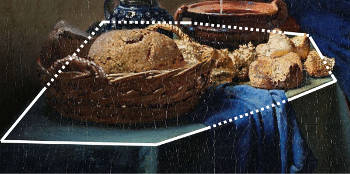
Johannes Vermeer
c. 1657–1661
Oil on canvas, 45.5 x 41 cm.
Rijksmuseum, Amsterdam
Some authors have faulted Vermeer for the seemingly bizarre perspective of the cloth-covered table of The Milkmaid. However, on close investigation it can been shown that the table does not have, as would be expected, a rectangular top. Based on Keith Cardnell's geometric reconstruction of the tabletop's surface (fig. 10 & 11),Keith Cardnell, "Vermeer, The Milkmaid: Notes On A Perspective Paradox (and the Perspective of the Original Examined). various seventeenth-century Dutch art experts have concurred that what we see is actually half of the top of a seventeenth-century gateleg drop-leaf table, which when open, has an octagonal top. Such a piece of furniture would have been readily understood by Vermeer's contemporaries.
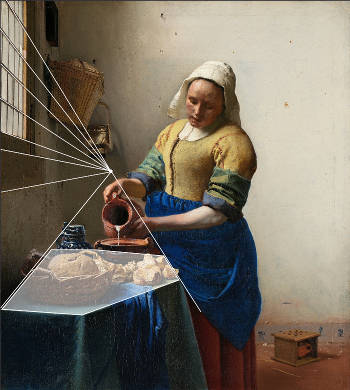
Johannes Vermeer
c. 1657–1661
Oil on canvas, 45.5 x 41 cm.
Rijksmuseum, Amsterdam
Cardnell also signaled another, perhaps more significant, perspective inconsistency. Given that, according to the rules of perspective, everything beneath the horizon line will be below the viewer's line of sight—the horizon line in The Milkmaid is cleanly above the left-hand arm of the figure—the observer should be able to see the horizontal surface of milk inside the opening of the earthenware jug held by the milkmaid. In other words, "the flat surface of the milk could not have disappeared until the flow had completely stopped." It is, however, impossible to know if such a divergence from perspective geometry is an ad hoc error, meant to improve the expressive impact of the painting by accentuating the black void of the jug's interior, or an observational oversight. Cardnell himself holds that since the milk stream is the primary focus of attention in the composition "it is inconceivable that special attention was not given to the source of the flow and the immediate surrounds." Cardnell also hypothesizes that the footwarmer is incorrectly foreshortened, skewed according to aesthetic requirements.
Being devoid of a gridded flooring one might suppose that there is no way to retrieve the distance points of The Milkmaid. However, as astutely illustrated by Cardnell, it is possible to attempt a reasonable approximation by utilizing the underlying geometry of the orthogonal table, and, more speculatively, the ellipse created by the round rim of the earthenware pot into which the milk flows. By fitting the jug's rim——it is describes and elipse on the picture plane—with a properly foreshortened square, diagonals can be projected upward to the left and right until they intersect the horizon line. Although the rim's ellipse is very regular, it is perhaps too small to provide anything more than a rough estimate of the location of distance points. On the other hand if we assume that top of the opened table describes a regular octagon, which seems reasonably, it provides a far more a reassuring basis for measurement (the pairs of distance points produced of the jug and the table do not overlay precisely). The distance points derived from the geometry of the table reveal that the eye point of the painter was, as in other early works, rather near to the subject the was painting.Due to the fact that there are no objects in the painting whose absolute measurements are known, it is not possilbe to assign an absolute value to the distance between the eye point and any the objects contained within the painting.
From a purely artistic point of view "the low viewpoint in The Milkmaid sits the viewer down in a chair on the near side of the table, his face on a level with the pitcher. Thus the bulky torso of the kitchen maid rises well above his head. If her face were seen from slightly above, her downcast eyes might be interpreted as a sign of modesty or servitude. But here the woman's glance suggests concentration and control."Walter Liedtke, The Milkmaid by Johannes Vermeer(New York: The Metropolitan Museum of Art, 2009), 11.
Despite the fact that linear perspective had been ubiquitously associated with the paintings of both the interiors and exteriors of buildings, the two surviving landscapes by Vermeer are essentially silhouettes, whose dark masses of dense worldly matter contrast with the vaporous world above it in both tone and painterly substance. Such a compositional formula seems somewhat puzzling because the graceful canal streets of Delft or, even better, the great space of the Market Place, would have provided text-book opportunities to exercise one's skills in one-point perspective. It is even more puzzling if we consider that Peter de Hooch had already employed linear perspective to great advantage in his endearing scenes of Delft's courtyards, which are generally considered to be the starting points for Vermeer's Little Street. One can only surmise that linear perspective was not an artistic priority at the moment he executed either of the two works.
The lazy convergence of the rows of cobblestones of The Little Street could conceivably be marshaled as evidence of linear perspective, but similar results could be gotten by eye measuring, or what painters call "eye-balling." In the more complex View of Delft the use of geometry would be superfluous for rendering the successive planes of the flat facades, since they present many traversals and vertical lines but, when projected on a planar surface, few traces of orthogonals. The sense of overall diminution of the town's brick buildings as they approach the horizon could have been attained by means traditional draftsmanship, by which the artist relies on the comparison of the dimensions of shapes of adjacent facades. Furthermore, only the grossest miscalculations in proportion would be noticed given that the dimensions of real constructions, analogous to trees in a forest, may vary considerably. A mistake might be perceived simply as a somewhat larger, smaller, higher or lower edifice. The camera obscura or the drawing frame might have made the task of drawing easier.
In the Girl Interrupted in her Music, presumably depicted before The Glass of Wine and The Girl with a Wine Glass, the lack of a tiled floor pattern makes it impossible to calculate where the distance points are located, although the orthogonals produced by the back side of the foreground chair intersect properly on the horizon line. The orthogonals produced by the lead mutins of the window sash converge accurately at the central vanishing point.
In the two early box-like interiors, The Glass of Wine and The Girl with a Wine Glass, Vermeer features colorful, diagonally set ceramic floor tiles in a very evident manner, and evident tip of the hat to a long traditon that dates back from the Renassiance. They are drawn precisely enough so that the distance points can be located for the first time with an acceptable degree of certainty. The horizon lines of both pictures are set relatively high. Various critics point out that the distance points are too close to the central vanishing point, causing distortions of the tiles at the foreground corners. Vermeer learned to mitigate this effect in the following works.
Assuming that the rooms represented in The Girl with a Wine Glass and The Glass of Wine were the same one pictured in The Music Lesson, Steadman noted various geometrical anomalies in both of the wine-glass pictures, which are painted in a relatively painterly style with respect to The Music Lesson. He writes that "in both these pictures, the nearer of the two casements in the central window is open. This casement, with its stained glass coat of arms, is very close to the picture's viewpoint in both pictures, and as a consequence is bound to appear very large in a true perspective image. However, Vermeer has managed to include the whole of the casement of The Glass of Wine. What is more, the casement has been opened to a narrower angle in the model—and so is somewhat more foreshortened laterally—in order that its right-hand frame might lie in the correct alignment relative to the pier and window beyond. In The Girl with a Wine Glass the open casement is again too tall."Philip Steadman, Vermeer's Camera: Uncovering the Truth behind the Masterpieces, (Oxford: Oxford University Press, 2001), 126–127. Such anomalies could indicate that the rooms are one and the same but the artist altered the windows' perspectives so that they would fit entirely within the composition and create a more desirable aesthetic outcome. Alternatively, all three paintings do not represent the same room. The art historian John Nash is not alone in criticizing another perspective anomaly of The Girl with a Wine Glass. He noted that "the proportion of the woman to her chair are…a little odd; it appears, from the perspective of the floor tiles, as if she is sitting at a little distance forward of the table, and yet the gallant who bends over her to press on her the glass of wine appears to be standing beyond the white tablecloth."
Whatever their level of perspectival accuracy, both paintings reveal a deepening interest in perspective construction and demonstrate the artist's desire to create the sensation of spatial depth in a more convincing, if not entirely concerted, manner than in previous pictures.
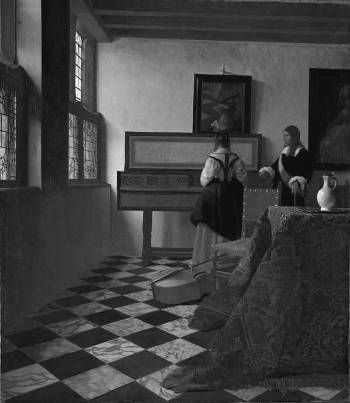
Johannes Vermeer
c. 1662–1665
Oil on canvas, 73.3 x 64.5 cm.
The Royal Collection, The Windsor Castle
The perspective of The Music Lesson is one of the most purposeful and artfully conceived of the artist's oeuvre, signaling an unbridled commitment to this aspect of his art. Both the orthogonals and the distance lines that can be extracted from the diagonally set floor tiles converge precisely at their respective vanishing points on the horizon line, as do those of the window.
Perhaps, because he was unsatisfied with the perspectives of The Glass of Wine and The Girl with a Wine Glass, Vermeer lowered the viewpoint of The Music Lesson and depicted much larger tiles. Steadman discovered that exactly four ceramic tiles of the previous pictures fit into one of the tiles of The Music Lesson (and in all subsequent paintings with tiled flooring). This lead him to speculate that the artist may have extracted a sort of geometrical grid from a room with real ceramic tiles, from which he developed different tile patterns according to the aesthetic exigencies of each new composition.
In any case, the tiles of The Music Lesson are arranged so that the white tiles are isolated from one another, dulling the effect of the receding orthogonals. Had, in fact, they been rendered in a straightforward checkerboard style (fig. 12), the effect of spatial recession would have been much stronger, perhaps overwhelming the broader compositional equilibrium (see reconstructed image above). Jacob Ochtervelt (1634–1682), who carefully kept track the Delft master's progress, seems to have understood Vermeer's lesson and painted tiles set in broadly spaced, diagonal patterns (fig. 13).
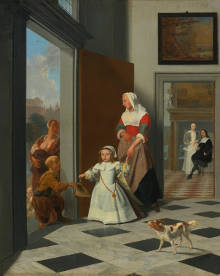
Jacob Ochtervelt
1663
Oil on canvas, 81.5 x 66.8 cm.
National Gallery of Art, Washington D.C.
It is likely that The Music Lesson was the model for another ambitious perspective, The Concert, whose compositional equilibrium is perhaps less successful than that of work on which it is based. Confident that the larger tiles of The Music Lesson create a more harmonious effect, Vermeer experimented with them agian in The Concert but arranged them in a black Maltese-cross pattern. Even though this particular pattern creates a somewhat disorderly effect with respect to the pattern of The Music Lesson, both the orthogonals and distance lines that can be retrieved from them are perspectivally correct. The same cannot be said of the chair of the male musician. While the vanishing lines that recede to the left converge correctly on the horizon line, those that issue to the right are almost parallel to each other and appear to be angled upward so slightly that they would, if ever, intersect the horizon line at an impossible distance from the painting. Consequentially, the right-hand side of the chair does not turn away from the observer realistically, giving the impression that the box-like volume of the chair's legs has been flattened.
Both the flat-bodied cittern perched on the tabletop and the large bass viol lurking in the extreme foreground of The Concert—the same bass viol is featured in The Music Lesson but less dramatically foreshortened—reveal the artist's desire to underline his virtuoso perspective skills. The drawing of foreshortened stringed instruments, particularly lutes and viols (fig. 14), were considered a formidable test of artistic ability and had engrossed painters since the Renaissance. Theey were frequently illustrated in perspective treatises, such as Albrecht Dürer's Underweyssung der Messung, of 1525. Lorenzo Sirigatti (1596–1625), an Italian sculptor and painter, wrote in his treatise, "It is held a most difficult thing to put into foreshortening regular bodies and above all those composed of curved lines such as the viola (fig. 15) and the lute." Such objects were routinely featured in European still lives in a variety of challenging positions. A close precedent for Vermeer's foreshortened viola da gamba can be found in Carel Fabritius's small canvas presumably made for a perspective box, A View in Delft, of 1652. Fabritius was lauded by contemporaries for his skills in perspective, and he briefly worked in Delft before his tragic death in the infamous Delft powder explosion.

Evaristo Baschenis
c. 1670
Oil on canvas, 75 x 108 cm.
Accademia Carrara, Bergamo
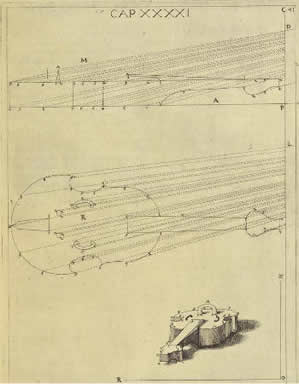
Lorenzo Sirigatti
1596
Venice, Girolamo Franceschi
In the single-figure interiors of the 1660s, sometimes referred to as the "pearl pictures," Vermeer utilized linear perspective far less obtrusively than in the earlier interiors. In most of these works the illusion of depth is created by the simple overlapping of form.
With so few geometrically regular elements visible to the spectator, it is nearly impossible to retrieve the perspectival armature of Woman in Blue Reading a Letter with any degree of reliability. Nonetheless, a few tenuous clues are available. Assuming that the table is set perpendicularly to the viewer's line of sight, a single orthogonal can be retrieved from its right-hand edge; the inside of the jewelry box is visible; and the uppermost tip of the lion-head finial of the right-hand chair is slightly above those of the background chair on the picture plane. Given these clues and the near vertical angle of the picture's only orthogonal, the central vanishing point can be speculatively located slightly below an imaginary line connecting the tips of lion-head carvings of the background chair, and to the left of the blue bow attached to the front of the figure's morning jacket.
Only two orthogonals can be extracted from the Woman Holding a Water Pitcher, but neither can be projected with sufficient precision as to produce a minimally valid vanishing point. On the other hand, the lines that can be projected by the obliquely set window appear to converge reasonably well. It is interesting to note than in Dutch interior paintings that feature similarly viewed windows the perspective lines generally do not converge with any degree of precision.
A Lady Writing also surrenders scarce evidence of its underlying perspective. Spatial depth was evidently not the primary question that occupied the artist's thoughts when he conceived this simple yet supremely evocative composition, although it would seem that the concept of point of view, perhaps, was. Only three clues provide us with any information. The barely visible light-gray upper surface of the jewelry box, which is set perpendicularly to the viewer's line of sight, reveals that the horizon line is located somewhere above it. And given that the box's right-hand-side is hidden from view the vanishing point of the picture must be located to its left. This is confirmed by the fact that when the vanishing lines created by the tips of the lion-head finials and the upper edge of the chair's seat are projected to the left, they appear to intersect with the orthogonal of the table's side edge, more or less near the edge of the painting. If this is true, the chair would be set perpendicularly to the viewer's line of sight, as would seem natural. Placing a vanishing point so close to, or perhaps even off, the edge of the canvas is unique for Vermeer and most likely represents a well-pondered decision.
Johannes Vermeer
c. 1662–1665
Oil on canvas, 55 x 45 cm.
Staatliche Museen Preußischer Kulturbesitz, Gemäldegalerie, Berlin
Curiously, the perspective of the ravishing Woman with a Pearl Necklace is below par. The orthogonals produced by the table, the ebony-framed mirror and the horizontal window leadings spread out somewhat erratically, failing to converge properly to a single vanishing point. The two vanishing lines that can be retrieved by connecting the appropriate brass studs on the seat of the foreground chair intersect below the horizontal line, but this error may be caused by the fact that the studs themselves were not originally positioned with mathematic precision. This unusual state of geometrical disorder, which in no way affects the tranquility of the scene, may be linked to the fact that the painting was heavily reworked by Vermeer. The original composition featured a cittern resting on the foreground chair, a large wallmap hung behind the figure and additional floor tiles beneath the table (fig. 16), all of which were painted over by the artist himself, presumably, for aesthetic motives. Unfortunately, the infrared radiograph that revealed these changes is not sharp enough to allow us to extract the orthogonals or the distance lines produced by the now-hidden floor tile. If nothing else, these anomalies demonstrate our tolerance to errors in perspective, and, perhaps, that the painter was not blindly doctrinaire in his application of perspective.
From a point of view of perspective construction the exception to the pearl pictures is the Woman with a Lute. The surface of this unlucky picture is so ravaged by time, and perhaps by man as well, that to pass judgment on the accuracy of its perspective would seem an act of bad will. Nonetheless, the picture originally provided many perspective clues, some of which are still avaialable. The orthogonals produced by the window elements converge properly toward the central vanishing point. Those of the background chair are somewhat more ambiguous due, in good part, to the difficulty in interpreting its fuzzy outlines and short segments. The two distance lines that can be retrieved from the floor tiles converge significantly below the horizon line. Curiously, the tiles themselves intersect with the base of the background wall at an arbitrary point, quite untypical for Vermeer. Even more incoherent are the vanishing lines caused by the braces and finials of the foreground chair. This sorry state of affairs must be attributed to the particularly ruinous state of the lower half of the painting, where the posts and braces of the chair can be barely distinguished from the muddy blue of the tablecloth, giving all the appearance of having been heavily reworked by a hand other than Vermeer's. This is unfortunate because it is clear that the painting was one of the artist's most pointed comments on the dramatic transformation that the shapes of objects may undergo when they are brought into rigorous geometric perspective. In this work the compositional scheme had been carefully devised to underscore how the lion-head finials of the foreground chair, which in reality fit comfortably in the palm of a hand, are nearly the size of the timid young musician's head when they are correctly projected onto the flat surface of the canvas. Despite the difference in mood of the two works, the perspectival armature of Woman with a Lute recalls that of the more colorful Officer and Laughing Girl, minus, of course, the latter's looming figure.
Given the complexity of The Art of Painting, it is remarkable that an in-depth technical examination of the canvas has revealed no pentimenti or construction lines, suggesting that both the painting's composition and perspective were thoroughly worked out before the artist set his brush to the canvas. Along with The Music Lesson this masterpiece is Vermeer's most committed perspective, although a few minor anomalies are to be expected.
Both the orthogonals and the distance lines converge at their appropriate vanishing points in an exceptionally accurate manner when compared to those of earlier works. And from what can be judged, the vanishing lines of the easel converge rather neatly, very near the horizon line. This is particularly noteworthy in that the point of intersection is quite distant from the surface of the painting. Had the angles of the easel had not been traced with a camera obscura or drawing frame, calculating the correct distance from the central vanishing point to the easel's "accidental" vanishing point would have involved some rather serious intellectual acrobatics. On the other hand, the vanishing lines produced by the background and the foreground chairs are not resolved with the same degree of precision. There is no way that we can know if such imprecision is due to the mechanical difficulties of projecting such exceptionally long lines, imperfect tracing or a misunderstanding as to where to locate the vanishing points of objects that are oriented obliquely but not at 45 degrees to the viewer's line of sight. The vanishing lines of the painter's stool betray a certain imprecision, which, however, can most probably be attributed to the difficulty of extracting full perspective lines, which, even if not perfectly calculated, would have virtually no impact on the picture's otherwise astounding level of perspective. In any case, recent examination of the picture has reveled a disturbance in the paint surface near the stool's vanishing point that may have been caused by a pin being inserted into the canvas. Presumably, a string would have been attached to the pin and pulled taut in order to designate or, more likely, verify the vanishing lines the stool.
![The Music Lesson (detail with missing tip of black tile [in red]), Johannes Vermeer, c. 1662–1665, Oil on canvas, 73.3 x 64.5 cm., The Royal Collection, The Windsor Castle](images/missing-tile-SML.jpg)
c. 1662–1668
Oil on canvas, 120 x 100 cm.
Kunsthistorisches Museum, Vienna
In an attempt to prove that Vermeer did not use the camera obscura as a means for tracing the composition of The Art of Painting, Gerhard Gutruf and Hellmuth StachelGerhard Gutruf and Hellmuth Stachel, "The Hidden Geometry in Vermeer"s 'The Art of Painting,'" Journal for Geometry and Graphics vol. 14 (2010), no. 2, 187–202. http://www.heldermann-verlag.de/jgg/jgg14/j14h2gutr.pdf have pointed a few minor errors in perspective. For example, they have shown that one corner of a black tile is missing to the right of the painter's right-hand stocking (fig. 17) and they hold that the foreshortening of both chairs is distorted. Furthermore, they claim that the seat of the painter's stool is larger than those of the two chairs, and its frontal edges are almost parallel to the crossbar and the baseline connecting its two legs—making it closer to an axonometric view than to a perspective—although the authors admit that this may be caused by the fact that the corresponding vanishing point is about "5.4 meters" to the of the left border line of the painting. The authors also noted that the black tiles on the bottom row are not continued below. Such anomalies, however, are so minor that it may be questioned if they can be reasonably marshaled as proof of which method the artist may or may have not adopted to create his perspectives. It s inevitable that errors of some sort would occur with almost any process, especially when portraying objects set at slightly oblique angles to the viewer's line of sight, some of whose distance points may be so far from the picture's surface that they can plotted with considerable difficulty. It is possible, for example, that the missing tip of the black tile may be nothing more than an aesthetic choice.
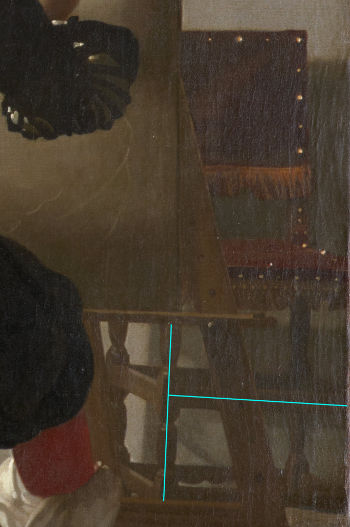
c. 1662–1668
Oil on canvas, 120 x 100 cm.
Kunsthistorisches Museum, Vienna
But the most serious deviation from geometrically accurate perspective in this masterpiece is "hidden" in the upholstered chair that is inelegantly chopped off by the right-hand edge of the picture (fig. 18). The chair is identical, presumably, to the chair set sideways in the extreme left-hand foreground, and save minor variations, to that in the foreground of The Love Letter. Aside from the fact that the structural elements of the accused chair intersect repeatedly with the legs of the easel causing a rather unusual compositional clutter, there is no need of a t-square to show that its legs and braces tilt seriously clockwise. Since there is little reason to believe that the chair itself was defective—it would have probably been structurally unsound—such errors would not have likely occurred had it been worked up with geometric construction, where measuring instruments would have been used. Nor is there any plausible reason to blame it on a drawing frame. One might offhandedly associate the defect with a distortion caused by the lens of a camera obscura in the periphery of the projection, but this cannot be reasonably advanced unless some sort of experiment is devised to test such an hypothesis. Moreover, the right-hand border of the map above the chair evidences no such tilt. For what it is worth, a photograph taken of a scaled reconstruction of the room as seen through a camera obscura does not evidence any tilt, despite the chair being rather unfocused.Robert Wald, "'The Art of Painting': Observations on Approach and Technique," in Vermeer: Die Malkunst, eds. Sabine Haag, Elke Oberthaler and Sabine Pénot, (Vienna: Residenz, 2010), 209.
In the large-scale Mistress and Maid, which may have followed The Art of Painting, there are only a few faint signs of linear perspective. The oblique angle of the light gray top of the jewelry box informs that the horizon line is above the box's upper surface. The orthogonals produced by the right-hand edge of the table, and the eleven written lines that can be barely made out on the letter, can be, if one is not too adverse to gross approximation, utilized to plot the central vanishing point somewhere on the maid's left-hand forearm or the olive-colored garment above it.
In the "scientific" pendant pieces, The Astronomer and The Geographer, the interplay between the perspective and the planar surface of the canvas is particuarly interesting. In The Astronomer an imaginary horizon line transits from left to9). It then passes through the length of the scientist's outreaching arm, establishing a formal bond between perspective and compositon which conveys purposeful determination to his action. Neither of these paintings is equipped a tiled flooring. This is most likely because the scene represented in the painting has been arranged in such a manner that only a few incomplete tiles would have been visible making it difficult to grasp the floor's overall pattern, while providing no clue as to spatial recession. In The Geographer the painter has inserted a stool set obliquely to the viewer's line of sight, perhaps, to enrich the three-dimensional space.
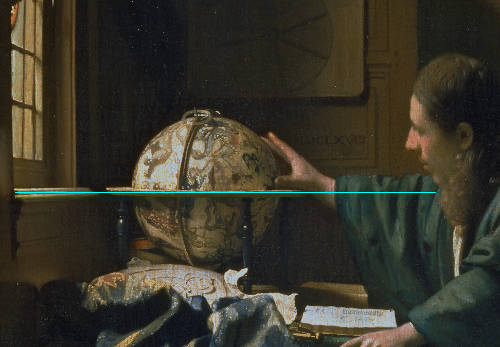
Johannes Vermeer
1668
Oil on canvas, 50 x 45 cm.
Musée du Louvre, Paris
In the stylish The Lacemaker and The Guitar Player the painter evidently found little use for linear perspective, opting, instead, for the succession of planes (i.e., overlap) to define space, albeit somewhat weakly with respect to works of the same period. In effect, it would seem that both pictures were intended to be read as more as planimetric surfaces, with texture, pattern and light reigning supreme.
The perspective of The Love Letter is rigorously defined by the receding orthogonals created by connecting the tips of the floor tiles, and the hanging bar of the foreground map. However, Steadman argues that "there are many details which, on close examination, combine to suggest that the foreground parts of the composition in The Love Letter are assembled by Vermeer as framing elements for the view beyond, and not as a completely coherent representation of some real door opening."Philip Steadman, Vermeer's Camera: Uncovering the Truth behind the Masterpieces (Oxford: Oxford University Press, 2001), 131. The view point is particularly distant from the background scene. Despite the careful perspective construction, the sensation of spatial profundity is challenged by the ambiguous rendering of the foreground room, which is not readily comprehensible to the average viewer. One early writer proposed that the background room was a reflection in a tall mirror set on a wall of a small, dimly lit room.
The interior space of the Lady Writing a Letter with her Maid is no doubt one of the most evocative of the artist's oeuvre. The orthogonals of the window frame and the succession of white floor tiles lead the eye discreetly toward the central vanishing point. The distance lines of the two most distant tiles are approximately drawn but such a minor deviation form geometrical perfection passes completely unnoticed to anyone without a ruler. The overlapping forms of the chair, table, the two figures and the picture-within-a-picture terminates with the humble whitewashed wall, confirming the sensation of depth created by perspective while simultaneously bonding the picture's most important iconographical elements. The foreground chair is set at 45 degrees to the viewer's line of sight, so its vanishing lines intersect, correctly, at the same point as those of the tiles.
The perspective of Allegory of Faith is, perhaps, as conventionally conceived as the picture itself. While the right-most vanishing lines created by the braces of the foreground chair converge correctly at the same point on the horizon line as those of the floor tiles—both objects are set at 45 degree angle to the viewer's line of sight—the distance lines of the tiles that converge to the left intersect at a point decidedly below the horizon line. Moreover, they fall short of the those of the chair, which, instead, are correctly drawn because they fall at a point equidistant from the central vanishing point. Such an anomaly, which appears to be systematic rather than accidental, is difficult to explain.
Without a doubt, A Lady Standing at a Virginal presents the most schematic perspective of Vermeer's oeuvre, in some respect recalling the hollow, box-like spaces commonly illustrated in period perspective manuals. Perhaps, in no other work did Vermeer employ linear perspective to control the viewer's attention so explicitly. Coupled with the rigorously determined recession of the floor tiles, the orthogonals–both to the left and right of the stately figure–draw the spectator into a vibrating but mathematically measured space where he or she is urged to come to terms with the solitary figure of the musician set in the dead center of the picture.
On the contrary, the space of A Lady Seated at the Virginal remains comparatively flat, despite the strong orthogonals of the virginal. The perspective, while largely accurate from a technical point of view, is not as functional to the composition as is that of its pendant, A Lady Standing. This is largely because the vanishing point is set behind the figure's shoulder, perhaps too far to the right, creating a large, open space that divides the figure from her instrument. In comparison, note how the figure and the virginal of A Lady Standing are sensed as single, tightly-bonded expressive entity
In any case, one has the impression that Vermeer's mature perspectives are largely precise, some surprisingly, or even unnecessarily, so. For example, by completing the perspective the floor tiles hidden by the foreground chair of A Lady Standing at a Virginal (fig. 20), it can be seen that the thin triangular shape located directly below the seat of the foreground chair (outlined in red in the diagrams below) is correctly painted with a light gray paint in order to indicate the presence of a white tile. Had the tile in question been depicted with black paint, the effect would have been negligible with respect the overall aesthetics of the painting.
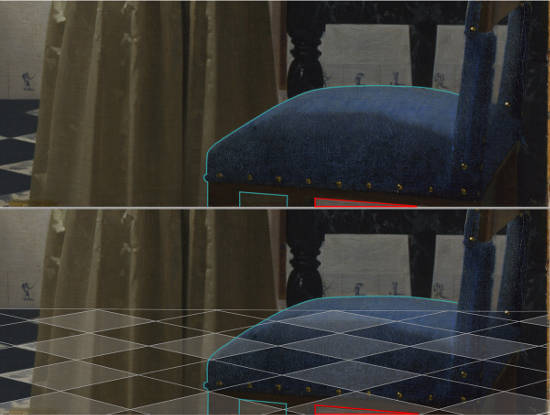
Johannes Vermeer
c. 1670–1674
Oil on canvas, 51.7 x 45.2 cm.
National Gallery, London
Another example of accuracy of Vermeer's perspectives is discussed by Steadman. In his geometric reconstructions he found that the pattern of floor tiles are painted with great precision in all cases. "It never happens that incompatible parts of a pattern are found in discrete parts of the floor. That is to say, the pattern always joins up correctly behind obstructions. This contrasts, for example, with the perspective of floor patterns in Pieter de Hooch's A Woman Drinking with Two Men. In this work De Hooch has added an extra impossible row of floor tiles at the left, in order to create more apparent space for the woman and side-table. If this row of tiles is extended to meet the back wall, it is seen to fall outside the room-although this fact is hidden by the placing of the larger table and the seated gentleman."Philip Steadman, Vermeer's Camera: Uncovering the Truth behind the Masterpiece ( Oxford: Oxford University Press, 2001), 80. Furthermore, Steadman notes that if the pattern of tiles is completed behind the figures de Hooch's A Soldier Paying a Hostess it becomes clear that De Hooch's detail does not conform to the correct perspective image of the grid.
Vermeer's Vanishing Points
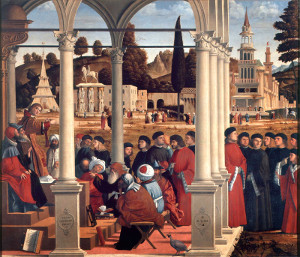
Vittore Carpaccio
1514
Oil on canvas, 147 x 172 cm.
Brera Pinacoteca, Milan
From the early 1400s, save rare exceptions, the vanishing point was always located within the perimeter of the painting, often near the geometric center. Artists seemed "unaware that it should be directly in front of the viewer's eye for the painting to be in correct perspective. The optimal location is presumably centered laterally in the canvas, at a height appropriate for a typical viewer. In any other position, the perspective projection would be distorted and the depth impression either reduced or skewed. An extreme case of such an offset is Carpaccio's Disputation of St Stephen (fig. 21). The horizontals [of the architecture] in this work would be parallel to the canvas if the vanishing point were centered, but should rotate back at the left side when the vanishing point is shifted to the right. The horizontals should then converge to an appropriate vanishing point at 4ight, but this necessity was not evident to any of the Renaissance artists surveyed"Christopher Tyler and Michael Kubovy, "The Rise of Renaissance Perspective," WebExhibits: Science and Art of Perspective. http://www.webexhibits.org/sciartperspective/raphaelperspective3.html In any case, it was probably understood that the vanishing point could be safely shifted to the left or right without evoking the sense of a distorted building as long as it did not go not beyond the boundary of the canvas. The architect Andrea Palladio (1508–1580) wrote that central perspective, instead, gives the picture maesta' e grandezza. It is commonly held that the central vantage point was a manifestation of Renaissance individualism in that the world is seen from a single point in space, that can only be occupied by a single person at one time.
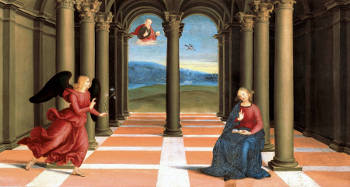
Raphael Santi
1502–1503
Tempera grassa (egg-oil) on canvas, 27 x 50 cm.
Pinacoteca, Vatican
Side-stepping philosophical ramifications, by placing the vanishing point near the center of the painting peripheral distortions are minimized and the effect of spatial depth is greatly amplified, creating the experience of an expanding funnel of space. As Arnheim points out, space "opens like a flower to the obseg4ver, approaching him directly…"Rudolf Arnheim, Art and Visual Perception: A Psychology of the Creative Eye (The New Version), Berkeley, Los Angeles and London: University of California Press, 1974, 294. This effect must have been greatly appreciated as it was the cornerstone on which a virtually incalculable number of European easel paintings were built (fig. 22).
In Vermeer's paintings most of the vanishing points are located near the center of the picture. Of the twenty-four interiors in which the perspective can be reasonably reconstructed, twenty put the viewer in a position slightly below the figure, which presumes that the painter worked while seated. According to Daniel Arasse, this point of view is found in very different subjects; it does not depend on the nature of the subject but tends to be a priori a principle of representation.Daniel Arasse, Vermeer, Faith in Painting. Princeton, NJ.: Princeton University Press, 1994, 59. Most of the vanishing points in Vermeer's paintings are placed slightly to one side of the composition. Four fall very near the center. None fall outside the perimeters of the canvas, except, perhaps, A Lady Writing.
Various art writers have conjectured that Vermeer located the vanishing points of his perspectives at thematically sensitive points of the composition in order to emphasize certain aspects of narrative. For example, the vanishing point of Woman Holding a Balance falls very near to the woman's upheld hand, presumably, to heighten the importance of her gesture. The vanishing point of Lady Writing a Letter with her Maid falls on the eye of the seated mistress. In The Music Lesson it falls on the lady's right-hand sleeve, presumably, to inform the viewer that it is she, rather than the gentleman to her right, who is the fulcrum of this complicated work, notwithstanding her back is turned to the viewer. Robert Huerta claims that in The Art of Painting Vermeer placed the vanishing point just below the model's right hand in order to draw attention to her, although one might wonder why he did not locate it directly on her hand a scant distance away and achieve even a stronger effect, if indeed drawing attention to the muse through perspective was Vermeer's intention. Arthur K. Wheelock Jr. speculates that the artist carefully constructed the perspective of Officer and Laughing Girl so that the vanishing point might fall directly in line with the figures' gazes and thereby intensify their dialogue.Arthur K. Wheelock Jr., Vermeer, London: Thames & Hudson, 1988, 64. The art historian Yoriko Kobayashi-Sato posits that an analogous trick was used in The Milkmaid, where the vanishing point is located strategically "above and behind the right hand, where the viewer's gaze meets that of the maid."Yoriko Kobayashi-Sato, "Vermeer and his Thematic Use of Perspective," in In his Milieu: Essays on Netherlandish Art, in Memory of John Michael Montias, eds. Amy Golahny, Mia M. Mochizuki and Lisa Vergara, Amsterdam: Amsterdam University Press, 2009, 212. She also finds that the vanishing point of The Love Letter is "closely connected" to the gaze of the two figures by "a line that leads to the vanishing point." Jørgen Wadum remarked that although the vanishing point of the Girl Reading a Letter by an Open Window now falls on the blank wall behind the girl's back, a point of the picture devoid of symbolic significance, x-ray images reveal that it originally fell on the lower edge of a large ebony-framed Cupid, presumably, in order to emphasize the amorous content of the letter held by the letter reader that Vermeer later painted out.
The conservator Robert Wald looks into the substrate of Vermeer's most complicated construction, The Art of Painting, and submits that its perspectival construction (largely determined by the location of the vanishing point) is based on the golden measure, a geometric ratio that has fascinated Western intellectuals of diverse interests for at least 2,400 years. Although admitting that "this could be a coincidence founded in the practices eye of the artist," Wald believes "it is more likely to have been a conscious arrangement of space according to a predetermined (and known) formula."Robert Wald, "'The Art of Painting': Observations on Approach and Technique," in Vermeer: Die Malkunst, eds. Sabine Haag, Elke Oberthaler and Sabine Pénot, Kunsthistorisches Museum, Vienna: Residenz, 2010, 314. In a somewhat similar approach, Desmond Shawe-Taylor, the Surveyor of the Queen's Pictures, the Royal Collection, notes that "the vanishing point [of The Music Lesson] (probably the first decision of the composition) lies near the lower apex of the lady's left sleeve, dividing the paint surface into ratios of two to three (on the horizontal) and four to five (on the vertical). Strings of these lengths would yield harmonies of a perfect fifth and a major third respectively."Shawe-Taylor,."The Art of Music,"Apollo, March, 2011.
In many of Vermeer's paintings, however, the vanishing point falls on neutral subject matter. For example, in The Geographer it falls amidst the empty, nondescript shadow projected to the right by the cupboard, hardly a strategic point of the picture from any point of view. Certainly, of all the artist's works the scientific subject matter of this picture would seem the most congenial to endowing the vanishing point with symbolic significance—any self-respecting geographer of the time would have certainly been skilled in perspective.
Admitting that in some cases the vanishing point does fall on a thematically sensitive point as some writers claim, this fact does not necessarily imply that the artist consciously calculated it to fall there a priori. Chance always lurks, and, perhaps more importantly, in those pictures where the vanishing point seems to fall on a symbolically sensitive location it may be because the painter had performed the very natural act of sitting directly in front of a part of the composition he wished to paint with greater attention, automatically establishing the vanishing point directly in line with his gaze.
Since there exists no historical evidence that might suggest Dutch painters conceived vanishing points in relation to theme, a cautious approach to the matter is advisable. In effect, after careful consideration there exists sufficient, but certainly not overwhelming, evidence to claim that Vermeer deliberately positioned the vanishing point of his perspective in only two works: The Astronomer and Woman Holding a Balance. In these works the vanishing point coincides reasonably well with the geometrical center of the composition, a rather unlikely statistical event. By superimposing the vanishing point on the geometric center of the painting, the opposing realities of the work—the perspectival construction that creates an illusion of depth and the flat picture plane on which the painter factually lays his paints—the artist presumably intended to draw the two into physical relation.
